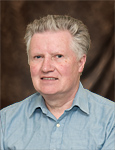Richard J. Puddephatt

Contact Information
Title: Distinguished University Professor
Office: Rm 100 ChB,
Lab: Rm 102-104 ChB,
Phone (Office): ext 86336
E-mail: pudd@uwo.ca
Research Areas
Organometallic Chemistry Related to Catalysis and Materials Science
Traditional Research Division:
Inorganic
Education
B.Sc. (London); Ph.D. (University College London)
AWARDS
- Officer of the Order of Canada
- Fellow of the Royal Society, FRS
- Fellow of the Royal Society of Canada, FRSC
- Canada Research Chair
- Bucke Science Prize and Hellmuth Prize, University of Western Ontario
- Alcan Award and E.W.R. Steacie Award of the Chemical Society of Canada
- CIC Medal of the Chemical Institute of Canada
- Nyholm Lecture Award and Award for Chemistry of the Noble Metals of the Royal Society of Chemistry
- E.G. Pleva Teaching Award
RESEARCH
Organometallic chemistry is of central importance in both catalysis and materials synthesis.
Current research in these areas is described below.
- We design, synthesize and study the properties of unusual organometallic polymers including those with tree-like or dendrimeric structures and conjugated, rod-like structures. The self-assembly of polymers, rings, catenanes and other potentially useful molecular materials is also of interest. In addition we design new volatile organometallics for application in low temperature Chemical Vapour Deposition for the synthesis of thin films of metals, metal oxides and other metal-containing materials. These find applications in fields as diverse as microelectronics, wear protection and biomaterials.
- We design, synthesize and study the chemistry of binuclear to tetranuclear complexes of platinum and platinum group metals containing metal-metal bonds. The aim is to design reactive compounds which are able to mimic chemisorption and steps in catalysis on heterogeneous platinum metal catalysts. Our recent research has been focused on complexes with Pt-M bonds (M = Re, Ru, Ir) as models for platinum and bimetallic catalysts and on complexes with Ru-Ru bonds as catalysts for transfer hydrogenation and polymerization. In this way, the complex reactions of catalysis may be simplified and understood. A related area is organometallic host-guest chemistry, building bowl-like organometallic hosts which can selectively bind anions or organic molecules and then take part in catalysis. The organometallic chemistry of platinum, especially as it relates to the activation of alkanes, is another central area of research.
Students in both areas learn the techniques of synthesis and characterization of organometallics and also have opportunities to work on reactivity and mechanism, structure determination or materials properties.
TEACHING
- 2281g - Inorganic Chemistry of the Main Group Elements
- 3330f - Industrial Chemistry
- 4441a - Inorganic Macromolecules
- 4471a - Transition Metals and Catalysis
- 4481b - Solid-state Inorganic Chemistry and Materials
- 4490e - Research Project
- 9651b - Organometallic Chemistry I
- 9651q - Organometallic Chemistry for Bond Activation
- 9651s - Organometallic Chemistry for Bond Activation
- 9651t - Organometallic Chemistry for Bond Activation
- 9658y - Topics Seminar
- 9671t - Synthesis with Organometallics
PUBLICATIONS
- Nasser, N., Eisler, D.J.; Puddephatt, R.J., 2010, “A Chiral Diphosphine as trans-Chelate Ligand and its Relevance to Catalysis,” Chem. Commun., 46, 1953-1955.
- Yue, N.L.S.; Jennings, M.C.; Puddephatt, R.J., 2010,“Dynamic Ring-Opening Polymerization of Silver(I) Complexes with Bis(amidopyridine) Ligands,” Dalton Trans., 39, 1273-1281.
- Au, R.H.W.; Jennings, M.C.; Puddephatt, R.J., 2009, “Self-Assembly of Chiral Organoplatinum(IV) Complexes with Both Carboxylic Acid and Amide Groups,” Organometallics, 28, 5052-5060.
- Safa, M.S.; Jennings, M.C.; Puddephatt, R.J., 2009, “A Double Cubane Structure in Organoplatinum(IV) Chemistry,” Chem. Comm., 1487-1489.
- Puddephatt, R.J., 2008, “Macrocycles, Catenanes, Oligomers and Polymers in Gold Chemistry,” Chem. Soc. Rev., 37, 2012-2027.

